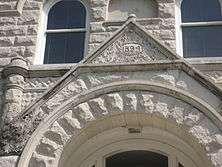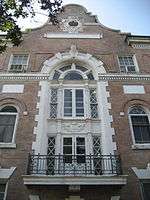Tulane School of Architecture
 | |
| Type | Private |
|---|---|
| Established | 1894 |
| Dean | Kenneth A. Schwartz, FAIA |
Academic staff | 40 |
| Undergraduates | 276 |
| Postgraduates | 37 |
| Location | New Orleans, Louisiana, United States |
| Campus | Urban |
| Nickname | TSA |
| Affiliations | NAAB, AIAS |
| Website | http://www.tulane.edu/~tsahome |
The Tulane School of Architecture or (TSA) is the school of architecture at Tulane University in New Orleans, Louisiana. The school has a student body of approximately 300 students and is known for the scholarly productivity of its faculty, its collegian atmosphere and unique studio culture.
Recognized as a strong Southern school of architecture, the School has gained international prominence for its design leadership in the aftermath of Hurricanes Katrina and Rita. The School's location in New Orleans has also provided the school with a unique laboratory for its urban research and noted historic preservation program. Degree paths for students lead to a 5-year professional Masters of Architecture, a 3 1⁄2-year professional Masters of Architecture intended for those holding undergraduate degrees outside of architecture, a 1 1⁄2-year program for pre-professional degree holders in architecture as well as the post-professional Master of Architecture II. The School also has programs leading to a Masters of Preservation as a graduate program and a certificate of preservation for undergraduates.
History
In 1894, Tulane University offered the first courses in architecture leading to a degree in architectural engineering under professor William Woodward. At this time, only about a dozen schools of architecture had been established in the United States. A full four-year professional curriculum in architecture, leading to the bachelor's degree, was established in the College of Technology (Engineering) in the 1907-1908 academic year. In 1912, Professor Nathaniel Cortlandt Curtis was appointed head of the newly independent Architecture Department; his successors were Professor John Herndon Thompson in 1921 and Professor Buford L. Pickens in 1946.
At the conclusion of the Second World War, the faculty and enrollment increased to accommodate returning veterans. The school continued to grow throughout the next two decades. John Ekin Dinwiddie was appointed dean of the School of Architecture in 1953; Professor John William Lawrence succeeded him in 1960. In 1971, the School of Architecture renovated and moved into its present facility, the Richardson Memorial Building, and experienced another increase in enrollment that continued throughout the 1970s. Professor William Kay Turner became the dean in 1972, and in 1975 a small graduate program was initiated, offering a course of study leading to the Master of Architecture II as a second professional degree. In 1981, after beginning his service as dean the previous year, Professor Ronald Coulter Filson established the Architectural Coalition for professional research and practice by faculty and students. Professor Donna V. Robertson succeeded Dean Filson in 1992. Upon the resignation of Dean Robertson in 1996, Professor Donald F. Gatzke was appointed acting dean. After a year-long search, Dean Gatzke was appointed dean in 1997. In October 2004 Reed Kroloff was appointed dean of the School after the departure of Dean Gatzke. Dean Emeritus Filson served as interim dean during the search.
In the summer of 1990, the School began a program offering a Master of Architecture I as a first professional degree for students with undergraduate degrees in other disciplines. The program awarded its first degrees in 1993 and was granted accreditation in 1994. In the fall of 1997, the School initiated a Masters in Preservation Studies Program with a first-time enrollment of ten students. Also in 1997, a supplemental Certificate in Preservation Studies was offered to undergraduates for the first time. The School began in 1999 offering a five-year Master of Architecture I (professional degree) to students who have not earned a bachelor's degree.[1]
Tulane City Center
After the devastation of New Orleans after hurricanes Katrina and Rita in 2005, the program became a vital part in the reconstruction of the city. The Tulane City Center houses the School of Architecture’s urban research and outreach programs. Programs of the City Center vary over time, but share a focus on improving cities through fostering global urban research, the development of flexible and innovative urban strategies, and the provision of environmentally and culturally informed principles to guide the design and revitalization of the contemporary metropolis.[2] Tulane City Center Aims to: 1) To provide a forum and administrative structure for students and faculty at TSA to work on projects in partnership with community-based organizations in the greater New Orleans area. 2) To promote the role of design in the early stages of community-based development initiatives—with special attention to the integration of sustainable ecological systems. 3) To expose students to design and development environments not typically associated with private practice because of extreme budget limitations and client experience. 4) To build and maintain an asset for TSA that serves to attract and retain high quality students and faculty. 5) To provide a constructive and critical voice in the ongoing dialogues on the future of New Orleans, particularly as it relates to excellence and leadership in design and planning.
Programs currently under development at the City Center include the University/Community Design Partnerships, Greenbuild, and a number of events and applied research initiatives.[3]
URBANbuild
URBANbuild is an urban design and construction program launched by the School of Architecture in 2005. Students engaged in URBANbuild studios are deployed to neighborhoods throughout the city to develop creative and sustainable urban design strategies, innovative designs for new housing, historic property inventories, and proposals for site-specific urban interventions and large-scale mixed use urban environments. As an integral component of the URBANbuild program, students will also design and construct a prototypical house for each of the study neighborhoods in partnership with community non-profit agencies that specialize in affordable housing and neighborhood redevelopment. URBANbuild is a laboratory for city research and design, a real generator for urban transformation and revitalization, and a program which directly engages students in the processes of digital fabrication, materials’ research and advanced construction processes and technologies.
Tulane Regional Urban Design Center (TRUDC)
Directed by Professor Grover Mouton, the TRUDC enlists graduates and students of the School of Architecture to work with communities in Louisiana, the Gulf Coast, and other areas to improve and develop their urban potential. TRUDC faculty and students concentrate on urban design, programming, and client-user group mediation. TRUDC’s recent history has been marked by exceptional opportunities in Asia, thanks to its strategic partnership with the American Planning Association. Projects in the Yangtze Delta have explored the issues of rapid urbanization in Asia and included discussions with a range of design professionals and Chinese Government and Planning Officials. Many of the issues the TRUDC introduces and explores in Asia are also being studied in Southern Louisiana’s small rapidly growing communities. Open to new ideas, these communities give students the opportunity to become involved in real-world planning projects across the Gulf Coast Region.
Notable alumni[4]
- Nathaniel C. Curtis, Jr., and Arthur Q. Davis, of the firm Curtis and Davis, Architects of Louisiana Superdome, Embassy of the United States in Saigon, South Vietnam.
- Robert Ivy, Chief Executive Officer of the American Institute of Architects[5]
- A. Hays Town, architect
- Samuel Wilson, Jr., preservation architect
- Bernard Lemann, architectural historian
- Albert C. Ledner, architect
- Moise H. Goldstein Sr., architect
- Wellington "Duke" Reiter, AR '81, president, School of the Art Institute of Chicago
- Jing Liu, architect, co-founder of the award-winning design firm SO – IL
Notable faculty
- Errol Barron, of the firm Barron + Toups, architects of the Ogden Museum of Southern Art
- Richard Campanella, geographer, definitive researcher on New Orleans historic geographic and urban landscape.
- Charles R. Colbert, architect of the Phillis Wheatley Elementary School, New Orleans
- Ammar Eloueini, architect, creator of unique chair design, CoReFab#116, that is in the permanent collection of the Museum of Modern Art in New York City
- Ronald Filson, FAIA, architect of the renovation of the Piazza d'Italia
- Reed Kroloff, former dean, former editor of Architecture magazine
- Kenneth A. Schwartz, FAIA, dean and Favrot Professor
- Judith Kinnard, FAIA, President-elect NAAB
Lectures, Events and Honors
The John W. Lawrence Memorial Lecture
Each year a particularly distinguished architect or scholar is invited to the School of Architecture to deliver a special lecture in honor of its late Dean, John W. Lawrence. Lawrence lecturers have included Louis I. Kahn, Charles Willard Moore, Arata Isozaki, Mario Gandelsonas, Peter Eisenman, Rem Koolhaas, Bernard Tschumi, and Greg Lynn.
The Arthur Q. and Mary Davis Visiting Critic
Through the generosity of New Orleans architect and Tulane School of Architecture alumnus Arthur Q. Davis and his wife Mary Davis, each year the School is able to invite a prominent architect, usually from outside the United States, to spend time in the School participating in our academic life, and to deliver a public lecture. Critics have included Zaha Hadid, William Alsop, Enric Miralles, Jacques Herzog + Pierre DeMeuron, Peter Zumthor, and Rafael Moneo.
Favrot Visiting Chair
The Favrot Chair in Architecture is made possible by the generous gifts of H. Mortimer Favrot, Jr. and his wife Kathleen Gibbons Favrot, in honor of his father, H. Mortimer Favrot, and grandfather, Charles A. Favrot. These three generations of architects have left an enduring architecture legacy for the state, the city, and the Tulane campus. Lecturers have included Coleman Coker, Vincent James, and Hans Peter Woerndl.
Other Activities
The School also sponsors and supports traveling fellowships for students through the Lawrence, Class of 1973 and Goldstein Fellowships. The Harrison Symposium is an annual event established to strengthen and enhance the area of curriculum known as Professional Practice. The Architecture Student Government organizes an annual all-school design and build charrette- Architects Week concluding in the Beaux Arts Ball.
See also
References
- ↑ http://alumni.tulane.edu/potpourri/IE.pdf
- ↑ http://www.tulanecitycenter.org/what-we-do
- ↑ http://www.tulane.edu/~tsahome/TulaneCityCenter.html
- ↑ List of Tulane University people
- ↑ http://www.aia.org/about/structure/AIAB099628
